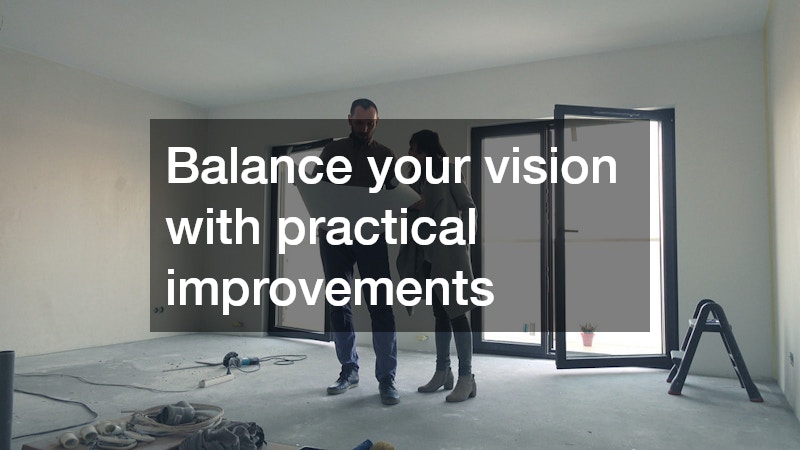Summary:
-
Clearly define your vision, priorities, and must-have features before meeting your builder.
-
Choose home builders with good communication skills who listen, respond, and provide regular updates.
-
Use visual aids like sketches, 3D models, and material samples to convey ideas accurately.
-
Maintain consistent, documented communication throughout the project to prevent misunderstandings.
-
Be open to professional suggestions while keeping your core vision intact.
-
Address miscommunications promptly and professionally to keep the project on track.
-
Collaboration and clarity with your builder lead to smoother projects and better results.

When planning a home renovation, remodel, or new construction, one of the most crucial factors for a successful project is how well you communicate your vision to your home builder. Even the most experienced builder can struggle to deliver results that match your expectations if they don’t fully understand your priorities, style preferences, and functional requirements. Miscommunication can result in delays, cost overruns, and unnecessary stress, which is why identifying and working with home builders with good communication skills is essential.
Sharing your vision effectively isn’t just about describing what you want; it involves providing clear, actionable guidance, using visual tools, establishing structured communication channels, and collaborating in a way that ensures your ideas are understood and implemented correctly. This article provides comprehensive strategies to help homeowners communicate their vision clearly and work successfully with home builders with good communication skills.
Understand Your Own Vision First
Before you approach any builder, it’s essential to have a detailed understanding of your own vision. Many homeowners start projects with only a general idea of what they want, which can make communication with builders frustrating and unproductive. The clearer you are about your expectations, the easier it is for a builder to translate those ideas into reality.
Start by defining your goals. Ask yourself what matters most—functionality, design aesthetics, sustainability, or budget. For example, you may prioritize an open-concept layout, energy-efficient features, or high-end finishes. Identifying your non-negotiables will guide discussions with your builder and help them make decisions that align with your priorities.
Gathering inspiration is another key step. Browse home design magazines, websites, or apps like Houzz and Pinterest to collect images of spaces you love. Take note of color schemes, layouts, and materials that appeal to you. This helps provide tangible references for your builder and ensures you’re on the same page.
Finally, separate must-haves from nice-to-haves. Must-haves are essential elements that you can’t compromise on, while nice-to-haves are features that enhance the design but aren’t critical. This distinction allows home builders with good communication skills to make informed recommendations when adjustments are necessary due to budget or structural limitations.
Tips for clarifying your vision:
-
Create a detailed list of priorities, including layout, finishes, lighting, and storage needs.
-
Collect visual inspiration through photos, sketches, or online mood boards.
-
Research materials and finishes to understand quality and cost considerations.
-
Identify constraints like budget limits, timeline, and space restrictions.
-
Rank your features as must-haves and optional enhancements for easier decision-making.
Choose Home Builders with Good Communication Skills
The quality of your communication starts with selecting a builder who is attentive, responsive, and capable of understanding your vision. Not all builders communicate effectively, and even skilled contractors may struggle if your communication styles don’t align. Choosing home builders with good communication skills can significantly reduce stress and improve the final outcome of your project.
When researching potential builders, look at reviews, ask for referrals, and examine their portfolios. Focus on their responsiveness, attention to detail, and willingness to listen. During consultations, pay attention to whether they ask clarifying questions, offer practical advice, and show genuine interest in your ideas. These traits are strong indicators that the builder values clear communication.
Ask specific questions to gauge communication style:
-
How do you keep clients updated on project progress?
-
How often are meetings scheduled, and what format do they follow?
-
How do you handle change requests or unforeseen challenges?
-
Can you provide examples of projects where you collaborated closely with homeowners?

Tips for finding home builders with good communication skills:
-
Review portfolios to ensure their design style aligns with your vision.
-
Ask for references from past clients, particularly about communication quality.
-
Confirm that the builder is comfortable using visual aids, drawings, or digital tools.
-
Evaluate their availability and willingness to provide regular updates.
-
Seek builders experienced in collaborative design processes and transparent decision-making.
Working with builders who have strong communication skills ensures that your expectations are understood, reducing the risk of misunderstandings or costly mistakes.
Use Visual Tools to Communicate Clearly
Visual aids are essential for bridging the gap between your ideas and the builder’s understanding. While verbal descriptions are helpful, they are often subjective and can be misinterpreted. Sketches, 3D renderings, and digital models provide a shared reference point that ensures clarity.
Digital tools like SketchUp, Home Design 3D, and virtual walkthrough platforms allow you to create detailed floor plans and visualize layouts in three dimensions. Even simple hand-drawn sketches with annotations can help communicate your ideas effectively. Visual tools also enable builders to identify potential challenges or limitations early in the planning process.
Physical samples of materials, such as paint swatches, flooring, tiles, and fabrics, are equally important. They help builders understand the textures, colors, and finishes you want, ensuring that expectations match reality.
Practical ways to use visual tools with your builder:
-
Collect photos of rooms, layouts, or features you love, and annotate them with specific notes.
-
Create mood boards or digital boards to convey your overall style and color palette.
-
Use apps or software for 3D modeling or virtual walkthroughs.
-
Bring physical samples of paint, tile, fabric, or flooring to meetings.
-
Label or organize inspiration materials to make them easy for the builder to reference.
Using a combination of visual and physical references ensures that home builders with good communication skills can interpret your vision accurately and minimize errors during construction.
Establish Consistent and Open Communication
Even after selecting a skilled builder, maintaining consistent and structured communication is key to a successful project. Clear communication doesn’t end after the initial consultation—it is an ongoing process throughout construction.
Decide upfront how often updates will occur and which channels you’ll use. Weekly or biweekly meetings may be appropriate, or you might prefer updates at key milestones. Documenting all decisions—via email, project management apps, or shared documents—reduces the risk of misinterpretation and provides a reference point if disagreements arise.
Tips for effective ongoing communication:
-
Schedule regular check-ins to review progress and address questions.
-
Use multiple communication channels, including email, phone, and apps like Trello or Buildertrend.
-
Keep a running log of approved changes, including materials, finishes, and layouts.
-
Confirm major decisions in writing to ensure both parties are aligned.
-
Encourage the builder to proactively communicate potential challenges, such as delays or material shortages.
Home builders with good communication skills thrive in structured communication environments. Setting clear expectations and maintaining regular contact fosters collaboration and reduces misunderstandings.

Learn to Speak Builder Language
Construction has its own terminology and processes, and understanding basic terms can improve communication significantly. Terms like “joist,” “beam,” “subfloor,” and “underlayment” have specific meanings, and knowing them helps you make informed decisions and avoid confusion.
Don’t hesitate to ask your builder for clarification when you encounter unfamiliar terms. Most experienced builders appreciate homeowners who are engaged and willing to learn, and they can explain concepts in a way that ensures you understand what’s feasible.
Tips for speaking the builder’s language:
-
Familiarize yourself with common construction and design terms.
-
Ask the builder to simplify technical explanations when needed.
-
Respect practical and regulatory limitations when discussing design ideas.
-
Maintain realistic expectations regarding budget, feasibility, and safety.
-
Review documentation and plans carefully to ensure you understand all details.
Home builders with good communication skills will adjust their explanations to match your knowledge level, creating a more collaborative environment.
Be Open to Professional Recommendations
While communicating your vision is essential, it’s equally important to remain open to professional suggestions. Builders have practical experience and knowledge of materials, construction techniques, and local regulations. Their input can improve functionality, durability, and cost efficiency.
For instance, a builder might suggest an alternative material that offers a similar aesthetic at a lower cost or greater longevity. They may also recommend design adjustments to comply with building codes, improve safety, or simplify construction. Being receptive to these suggestions does not mean compromising your vision—it means leveraging professional expertise to achieve a better final outcome.
How to consider professional recommendations:
-
Listen actively to the builder’s suggestions and understand the rationale.
-
Evaluate alternatives based on durability, cost, and functionality.
-
Balance your vision with practical improvements suggested by the builder.
-
Ask for visual examples or case studies of previous projects that used similar solutions.
-
Maintain a flexible mindset while preserving core priorities.
Builders who are experienced in working with homeowners understand the balance between honoring the client’s vision and applying practical expertise to achieve the best results.

Address Miscommunications Promptly and Professionally
Even with the best communication practices, miscommunications can happen. The key is to identify them early and address them constructively. Ignoring misunderstandings can lead to bigger issues, including cost overruns and dissatisfaction with the final result.
Recognize early signs of miscommunication:
-
Construction progress doesn’t match your expectations.
-
Frequent clarifications or questions from the builder indicate unclear instructions.
-
Differences between visual references and completed work.
Steps to resolve misunderstandings effectively:
-
Address the issue as soon as it arises to prevent escalation.
-
Use visual references, drawings, or samples to clarify your expectations.
-
Document discussions and agreed-upon solutions for future reference.
-
Keep the conversation professional and focused on solutions, not blame.
-
Follow up to ensure that agreed changes are implemented correctly.
Handling miscommunications professionally fosters trust and strengthens collaboration with home builders with good communication skills, ensuring the project continues smoothly.
Effectively sharing your vision with a home builder requires preparation, clarity, structured communication, and collaboration. By understanding your priorities, choosing home builders with good communication skills, using visual aids, maintaining consistent communication, learning construction terminology, being receptive to suggestions, and addressing issues promptly, you can minimize misunderstandings and achieve a home that truly reflects your vision.
Clear communication isn’t just about words—it’s about creating a shared understanding, building trust, and establishing a collaborative partnership. Homeowners who take a proactive, organized, and flexible approach often enjoy smoother projects, fewer conflicts, and results that exceed expectations.
Investing time upfront in clear communication and working with home builders with good communication skills pays dividends in efficiency, cost savings, and long-term satisfaction with your home.



